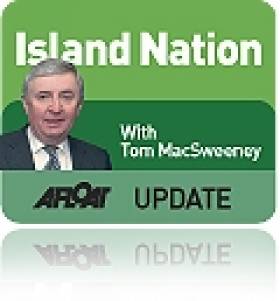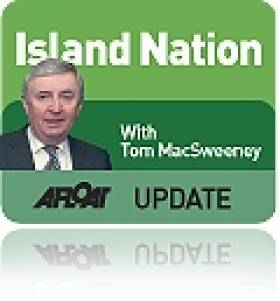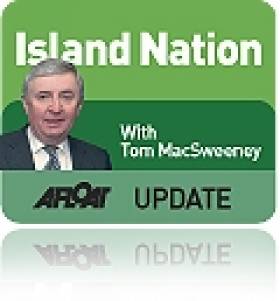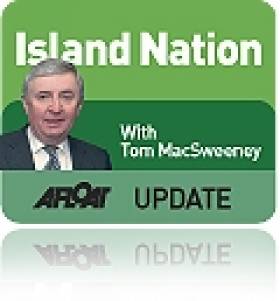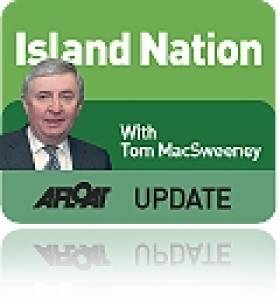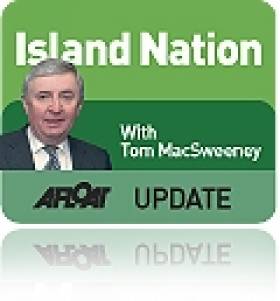Displaying items by tag: Island Nation
Tom MacSweeney's Maritime 'Island Nation' Column
#MARITIME – From Friday, May 4 I will be writing a new weekly page for the Afoat.ie website, covering the maritime sphere in its widest application – marine, shipping, fishing, leisure, research and development.
This will be accompanied by a monthly newsletter which will be circulated to readers of Afloat.ie.
Sign-up detais will issue on May 4.
We have further plans for development of maritime coverage through the Afloat.ie website, providing the widest coverage of the marine sphere.
I look forward to your interest in this new approach and you can also follow this coverage on Afloat Twitter and Facebook and on Twitter @TomMacSweeney and on my Facebook page.
Sailing Clubs Must Support Struggling Members
Last month AIB pulled the plug on sailing club fees for staff. Next month the Irish Sailing Association aims to rejig the annual fee it charges to clubs at an egm. They are signs that the necklace of over 70 yacht clubs around the coast and on inland waters are under financial pressure. No wonder as the cost of going sailing, as well as many other sports in Ireland, proves too much to bear for many families.
In his recent column (below) in the Evening Echo Marine Correspondent Tom MacSweeney highlighted the need for Sailing Clubs around the coast to do all they can to help struggling memberships.
Membership is becoming an issue for sailing clubs to judge from what club officers around the coast have been telling me. It is a sign of the economic times. Families and individuals have to examine closely what to do with the money they have left after the government has raided their incomes.
I have been told that club members and particularly those holding family memberships are looking at how much they pay for an inclusive membership and reducing it to just one individual membership. Others have told me that they are faced with deferring payments or foregoing membership altogether.
Clubs are responding to the situation in different ways.
While the more realistic are taking steps to deal with the issue, there are indications that others are ignoring a situation that, it appears, could affect the popularity of the sport. This may be from an entrenched position or snobbish attitude where they don't want to admit difficulties in public. An inadvisable situation when income is being squeezed and the future challenged.
Payment systems such as monthly standing orders, direct debits, concessions for early payments, have been introduced by those clubs realistically dealing with the situation. Sailing is not the only sporting activity being affected, I hear of golf, rugby, soccer and other clubs feeling the pinch of reduced incomes, soaring taxes and charges levied on household incomes by the government. Something has to give because there is a limit to the amount of money people have. Government politicians seem incapable of understanding that people have not got enough money or sufficient disposable incomes because of the State raping their salaries.
Another aspect of the impact of deteriorating income levels appears to be the demand for marina spaces, with boat owners not as active as they had been in seeking berths and telling me frankly they cannot stretch incomes to afford prices during high season. Some boatyards are feeling the effects also around the country, as are yacht sales. A lot of boats are for sale and replacement plans by sailors who had planned to upgrade have been put on hold.
The oldest yacht club in the world, the Royal Cork at Crosshaven, has been responding to the challenging times. Last season it introduced a monthly membership scheme and a crew membership system as an innovative response to the challenge which the sport faces.
When he took over as the club's new Admiral at its annual general meeting last Monday night in the Crosshaven clubhouse, Peter Deasy acted immediately, announcing that the club would take further steps to address the issue.
He has taken office for a two-year period in succession to Paddy McGlade, a post which follows his successful leadership of the last Cork Week two years ago when he was Chairman. Cork Week will be held again this year, from July 7 to 13.
"There is a membership challenge, it is one facing all clubs in these times and it will be addressed by this club," he said. He stressed the importance of encouraging more people into sailing. The club is to carry out a review of its membership system, amongst other steps. On Monday night members approved an increase in subscription levels for those over 65, who pay a reduced rate as 'seniors,' as is the situation in many clubs.
The RCYC is taking a realistic, determined approach toward what is an issue born of these difficult national economic times. Peter Deasy also emphasised the importance of encouraging young sailors and keeping them within the sport.
This is a topic I have addressed before. Not every young sailor will reach the top competitively, but all are needed to remain in the sport in this island nation. When they emerge from dinghies there is a difficulty, experienced in many clubs around the coast, of maintaining their involvement.
Naming a Lifeboat in Kilrush
I have been at many naming and launching ceremonies but never before had the honour of being invited to perform a naming ceremony. The spirit of friendship, of commitment to helping others, which is the hallmark of the RNLI, made it a very pleasant occasion.
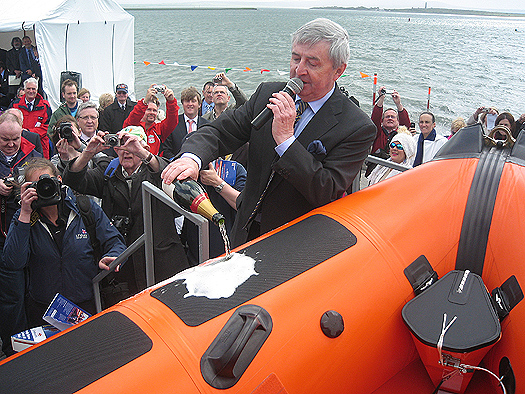
Kilrush has a strong maritime tradition, Steamers operated from there in the 19th century, towing lighters carrying cattle and other goods upriver to Limerick. A fleet of sailing boats, known as turf barges also carried various goods and vast amounts of turf to the Treaty City. Cappa, nearby, provided the pilot station for vessels entering the Shannon Estuary from the sea. The Royal Western Yacht Club was established in Kilrush in 1828.
The town is the base of the Irish Whale and Dolphin Group. Whale and dolphin watching is one of the boating attractions of Kilrush.
In recent years a marina built at Kilrush caused major controversy when it over-ran its budget.
"The manner in which the marina project was carried out may have justified criticism, but there was a predictability about it, coming from the national media, from political circles, from urbanites in Dublin and elsewhere who have no understanding of coastal areas," one of the men who campaigned for and defended the marina project, told me. "There are people who don't want the coastal areas to be better than urban centres, who don't want the rural areas to be more attractive than the urban jungles. There are benefits from maritime development, the marina is justifying itself, the yacht club has been revived, young people are taking up water sports, the leisure sector brings money into the town, the boat trips attract tourists."
Kilrush lifeboat station was established in 1996 to provide additional cover on the west coast, particularly on the Shannon Estuary. The boathouse and launching slipway were built facing Scattery Island, with access to the deepwater channel, providing housing for the lifeboat and launching vehicle, a workshop, fuel store and crew facilities.
The new boat is named Edith Louise Eastwick, in memory of the mother of the late Baroness Marjorie Von Schlippenbach. It was built at a cost of €185,000 and has a number of improvements from the Atlantic 75, Kilrush's former lifeboat, including a faster top speed of 35 knots, radar, provision for a fourth crew member and more space for survivors. It can operate safely in daylight in up to force seven conditions and at night up to force six. There is no greater gift that anybody can give than that of saving life.
I was told once by a lifeboat man that the gift they get is to see somebody safely ashore after they have rescued them. Isn't it the greatest gift lifeboat people give, saving someone else's life?
Is 'Marine' Being Got At Again?
My view was that it was a substantial change and that the pre-Election pledge of Fine Gael to co-ordinate all maritime aspects under one Department was being delivered upon and I welcomed the appointment.
But this week it has been pointed out that, while the names of other Government Departments have already been changed to their new designations under the Ministerial appointments announced in the Dail, this has not been done where the marine is concerned. The Department of the Taoiseach's website lists Simon Coveney's Department as "Agriculture, Fisheries & Food" and the Department is so far retaining that title. Its press releases have describe Coveney as "Minister for Agriculture, Food and Marine," not what the Taoiseach announced in the Dail.
This is not pedantic, but a reasonable issue to raise bearing in mind past marine experience. When Bertie Ahern abolished the Department of the Marine and assigned duties to the "Minister for Transport and Marine" in the last Government, top civil servants in that Department removed "marine" from its title. When I questioned that, I was told that a meeting of those officials had been held and that decision had been made.
So, I asked the Department of the Taoiseach this week, what exactly is the title of Simon Coveney's department. To the time of writing this column, no response has been received.
When he was Fine Gael Leader, Enda Kenny told me in a radio interview of his pride in the maritime connections of his family which had been involved in the lighthouse service.
I asked the Department of "Agriculture, Fisheries and Food" press office why "marine" was listed as third in the Minister's role rather than second, as described in the Dail. I was told that arrangements and decisions and an "SI" - "statutory instrument" - were awaited.
I will be interested to see how long that takes..
This article is reprinted by permission of the EVENING ECHO newspaper, Cork, where Tom MacSweeney writes maritime columns twice weekly. Evening Echo website: www.eecho.ie
Cheeky Chinese Challenge?
This is an interesting challenge to the present US holders, computer software billionaire Larry Ellison's Oracle Racing team which decided to have the event hosted by the San Francisco Yacht Club, which prides itself as being "the oldest club West of the Mississippi in North America."
It will be the first time the America's Cup has been hosted in the United States since 1995 and it is interesting to speculate whether the Chinese are cheekily challenging the Americans who don't like the Cup going outside of the States.
Racing will be held on the iconic San Francisco City front and be visible from world-renowned tourist destinations such as the Golden Gate Bridge.
"My support for San Francisco hosting the America's Cup goes beyond the opportunity to see our team competing on home waters," said Russell Coutts, CEO, ORACLE Racing. "We are excited to sail for our sport's greatest trophy, on a stretch of water legendary among sailors worldwide."
The China Team has been given the backing of the Chinese Government and has already been designing a boat for the 34th Cup event which will be raced in 72-foot wing-powered catamaran multihulls.
"We have been working with some of the best worldwide designers for hulls and wings for a few months in partnership with top Chinese universities," the Team Leader, Wang Chao Yong, said. "This is an opportunity to showcase Chinese talents at the leading edge in hi-tech areas of both hydrodynamics and aeronautics. Our boat will be built in China."
The Chinese made an unsuccessful attempt on the 2007 America's Cup. While the intention is that most of the sailors on their America's Cup team will be Chinese there is to be, as in the 2007 attempt, a French influence. Thierry Barto has been appointed Chief Executive Officer and given the task of getting top sailors to coach the Chinese team.
It seemed initially that interest might be lacking in the 162-year-old event. However ten teams have signed up to take part in the 34th America's Cup.
Aside from the defender, Oracle, entries include Team New Zealand, Italian syndicate Mascalzone Latino - the official challenger of record - and Artemis of Sweden. Two French teams and the Chinese have also paid their entry fees. America's Cup Racing Management says two other unidentified teams, one of which is believed to be Italy's Venezia Challenge, will take part. Whether all of the existing entries make it to the start line of the challenger elimination series in July of 2013 will be interesting. There was major legal action before the event was re-scheduled for 2013. Oracle and Ellison declared their preference for a defence in San Francisco as the "home club".
Two of the three possible French challengers had talks with the Minister for Sport in Paris last Friday to discuss amalgamation and whether there would be French government support. There is also an "Argo Challenge" from a group of disabled sailors.
• This article is reprinted by permission of the EVENING ECHO newspaper, Cork, where Tom MacSweeney writes maritime columns twice weekly. Evening Echo website: www.eecho.ie
Conference Hopes to Bin Ocean Debris
It was very topical, because this week the Fifth International Marine Debris Conference is taking place in Hawaii, organised jointly by the National Oceanic and Atmospheric Administration and the United Nations Environment Programme. This is an attempt to deal with the increasing problem of debris in the oceans of the world.
A United Nations report revealed some pretty frightening facts to the conference. Just two kinds of rubbish make up more than half the marine debris in the world. One is predictable enough – the horror of plastic choking sea life. The other came as more of a shock. The second most abundant kind of marine litter is smoking-related. Cigarette butts and packing account for nearly half of all sea rubbish in some parts of the world, according to the UN.
About 40 per cent of the litter in the Mediterranean Sea comes from this source. In Ecuador, smoking-related refuse accounted for more than half of coastal rubbish.
Ocean debris is a severe threat to the marine eco system. It kills at least 1 million sea birds and 100, 000 mammals each year, according to the United States National Oceanic and Atmospheric Association. The general prognosis at the conference in Hawaii has been pretty grim. Things are getting worse and it is the fault of humans on land using the oceans as rubbish dumps.
As my grandson's homework showed, it takes two weeks for a bit of fruit thrown into a river or the sea to bio-degrade. It will be two months before a piece of cardboard breaks down, three months for a milk carton and matters get worse where a cigarette butt is concerned. That will take ten years to disintegrate, a Styrofoam coffee cup 50 years, a plastic bag over a hundred and the six-pack ring so often tossed overboard from boats 400 years, with the plastic bottle even worse at 450 years.
The threat and impact of marine debris have long been ignored. Perhaps it is the perceived vastness of the ocean and lack of visibility of marine debris, but the teachers in Crosshaven national school, on the edge of Cork Harbour deserve praise for making their young pupils aware of what throwing litter into a river or dumping it on a beach does.
• This article is reprinted by permission of the EVENING ECHO newspaper, Cork, where Tom MacSweeney writes maritime columns twice weekly. Evening Echo website: www.eecho.ie
Marine is Back
It is a reminder which I hope that the media in general will note and that his tile of Marine will be used as often as agriculture is. The general media has been notorious, in my view, for disregarding the marine sector unless there is disaster, emergency or controversy involved.
The return of the title 'Marine' to a Government Department is, to put it bluntly, a kick-in-the-ass which civil servants needed. It was a betrayal of this island nation's heritage when those in charge of the former Department of Transport held a meeting which decided to remove the title marine from the Department's name, even though the then Minister had been assigned the role of Minister for Transport and Marine. The man in charge of that Department, Noel Dempsey, did not demonstrate a lot of interest in the marine, being more noted for trying to shut down the coastal radio stations at Valentia and Malin, where he was beaten off by public opposition, which also happened when he tried to remove 24-hour rescue helicopter service in the south-east and for his introduction of laws which criminalised fishermen.
Hopefully, the restoration of 'Marine' to a Department's name will be the harbinger of better things for the marine sphere.
I have heard some disappointment expressed that the marine is not a department on its own, but what the Fine Gael and subsequently Coalition Programme for Government agreed by Enda Kenny and Eamon Gilmore said was: "Marine responsibilities will be merged under one Department, for better co-ordination in policy delivery."
They have been, though some of the finer detail remains to be seen, such as will the ports be moved away from Transport, to where port companies and commercial interests originally campaigned to have them moved? And how will the split of marine tourism work between Agriculture and Marine and the separate tourism department? A similar issue may arise in regard to sailing and sport, but it seems to me a positive step that the disregard which Fianna Fáil and the Greens showed for the marine sector is being changed.
It was also right to end a separate department for defence. With a small army and navy, smaller than the marine sector, it was nonsense that it should have been a department of its own.
Let us therefore, hope for the future and take a positive view of the change as being for the better.
Afloat's March/April Issue Out Next Week!
Is there no end to the achievements of Irish boaters against seemingly impossible odds?
The winter may have been a time of hibernation for some of us but as the stories in Afloat's March/April issue will bear out Irish sailors have been battling the elements all winter long.
James Carroll competed in January's Sydney-Hobart offshore race and, much closer to home, Paul A. Kay journeyed through snow and ice in December from Dun Laoghaire to a new marina on Valentia Island.
As if to prove a point that we're down but not out, a winter of results on foreign waters includes a win in the Mirror World Championships in Australia and a top Olympic result in Florida, USA.
They are gutsy performances from youth teams that shows, if nothing else, the next generation of Irish sailors is really up for a fight. All this plus lots, lots more on news-stands next week!
Selected contents from Ireland's only boating magazine include:
News
Surveyors Issue Boat Launch Warning, Buoyant Dinghies Buck the Market, Ice Diving in Ireland, German U-Boat Rediscovered in Cork Harbour, an Historic Trophy for South Pacific Dream Cruise, MGM open in Cork, Hugh Mockler joins Crosshaven Boatyard plus lots, lots more.
News Focus
A new masterplan for Dun Laoghaire harbour is badly needed but it needs buy in from all those that use it
Going Offshore
The tenth Dun Laoghaire to Dingle offshore race was launched in style
Marine Conference
Combating the downturn was the focus of a unique marine gathering on both sides of the Irish sea.

Gear Review
New dinghy gear, a new Crosshaven boot from Dubarry, a new raincoat for girls and an upgrade for Musto's MPX.

This Island Nation
The decision to shut down the fog signals was based on a detailed risk assessment. Tom MacSweeney on the loss of fog horns
Sailor of the Year
Anthony O'Leary of Cork is the Afloat.ie/Irish Independent "Sailor of the Year" in celebration of his outstanding achievements afloat nationally and internationally.
Tall Ships
W M Nixon looks at the realities of national sail training in the 21st Century.
Tall Ship Conference
Ireland could yet have a tall ship to replace the Asgard II and the Lord Rank, if a new group formed to press for a replacement is successful
Racing update
Ulstermen's World Title, Topper worlds for Dun Laoghaire, Two Irish campaigns line up for Figaro Race, SB3 Sailors Cry Foul at Dun Laoghaire Parking Fees and an Irish entry in the Moth worlds in Australia, Irish Mini 6.50 Campaign in Prospect.

Youth Worlds preview
Results achieved abroad this Winter are the backbone for further Irish youth
success

Figaro Preview
Two fledgling Irish La Solitaire du Figaro campaigns edged closer to the start line last month
Volvo Dun Laoghaire Regatta
Volvo Dun Laoghaire regatta has taken in 22 entries six months ahead of the first race of the biggest regatta in Irish sailing.

Fireball Worlds preview
Dun Laoghaire's Noel Butler intends to continue his winning run in the Fireball class this season but the year ahead doesn't look so easy as the World Championships come to Sligo
Sovereigns cup preview
Up to 30 Quarter tonners will be at the Sovereigns Cup this year including one from New Zealand.
Shiver to deliver
A journey through snow and ice from Dun Laoghaire to Valentia Island
Sydney-Hobart Race
Outside of the Volvo Ocean Race, the Sydney Hobart is one of the world's most challenging offshore races. James Carroll Raced it in January.
Inland
As the cuts begin to bite, it may be time to look at the British direction for our waterways, writes Brian J Goggin
Dubarry Nautical Crossword
Soundings
A Google aerial photo proves useful navigating for Baldoyle Estuary
- Anthony O'Leary
- Dun Laoghaire
- Tom MacSweeney
- Harbour
- MGM Boats
- Asgard II
- World Championships
- Dinghies
- Olympic
- Cork Harbour
- Valentia
- Mirror
- Dingle
- youth
- Lord Rank
- Island Nation
- Hugh Mockler
- Dubarry
- Tall ship
- brokerage
- sydneyhobart
- fog horn
- moth
- Mini 6.50
- Uboat
- Fireball worlds
- Sovereigns
- James Carroll
- Paul A. Kay
- Crosshaven Boatyard
- Baldoyle
- MPX
- W M Nixon
Now There is None
What a magnificent sight it was as the three Tall Ships, each flying the Tricolour, headed the fleet of the gracious ships of sail from all over the world.
How different it will be in July when the world's Tall Ships again parade down the Suir. There will be no Irish national sailing ship to lead the parade. A number of private Irish entries are expected at Waterford from June 30–July 3 amongst the 70 vessels from around the world when the city has the honour starting the race. In 2005 about half-a-million people visited the city while the Tall Ships were there.
The lack of a national tall ship is another example of governmental maritime neglect, directly due to the decision of former Defence Minister Willie O'Dea, T.D. After the sinking of ASGARD he publicly committed the Government to its replacement, but after receiving insurance compensation money for its loss, he put the money into coffers of the Department of Finance and closed down the national sail training programme. There was a big difference between what he promised and what he did, a disregard for the maritime sphere which it is hard to forgive. I also recall how former Taoiseach Bertie Ahern did not visit Waterford during the 2005 race, when it was the biggest tourist event in the country. When I broadcast my report expressing astonishment at this snub government sources and Fianna Fail didn't like it. Truth in the news can be painful!
The organisers made contacts about the DUNBRODY, which continues to earn income at the New Ross quayside where it is moored as a tourist attraction and with the JEANIE JOHNSTON, moored at the Dublin Docklands.
However, neither will be taking part, the organisers have confirmed, tough they said that it was expected that about 100 young Irish trainees would sail aboard tall ships in the race, half of them with funding support from local authority, business and other sources. A group of Irish sailors have also indicated they are making arrangements to charter a UK-registered vessel the JOHANNA LUCRETIA for the event.
Once again the Irish Government has sunk to the bottom where maritime matters are concerned.
It was announced this week in Waterford that Fáilte Ireland has made a significant financial and marketing commitment to this year's event, though the financial figure was not disclosed .A free festival programme will feature street acts; comedy; international and home-grown artists, nightly fireworks, an artisan food village and an atmosphere which the organisers say "will thrill people of all ages and nationalities."
• This article is reprinted by permission of the EVENING ECHO newspaper, Cork, where Tom MacSweeney writes maritime columns twice weekly. Evening Echo website: www.eecho.ie
Lifejackets and Many Kinds of Racing
The wearing of jackets is not compulsory, but a decision for the individual sailor, though Skipper can insist that crews use them while racing.
In the United States a debate is underway as to whether the wearing of jackets at all times on racing boats should be made compulsory by law. Regulations here require that everyone on board any boat of seven metres or less, approximately 22 feet, must wear lifejackets. They must be carried aboard for everyone on any vessel regardless of size. Every child less than 16 years of age must wear a lifejacket or personal floatation device at all times on deck while the craft is underway.
As owners prepare boats for racing this season, these regulations should be kept in mind. Enforcing the law, or even effectively checking its application remains patchy. Introducing laws is easier than implementing them, particularly in a yacht racing situation. Sailing clubs have their own enforcement arrangements and insist on buoyancy aids for dinghy racing.
Safety on the water is an issue for each individual, but skippers/owners would be well advised to protect themselves in this litigious nation by insisting on the wearing of lifejackets by crew members during racing. Accidents will happen. Preparation is best.
The national sailing association, the ISA, is to nominate teams for this year's Nations Cup match racing. The finals will be held at the USA Sailing Centre in Wisconsin from September 13-18.
The Irish Sailing Association this week sought expressions of interest from skippers who would like to represent Ireland, in the first instance at the European Regional Finals in Gydnia, Poland, from July 19-23.
Ireland is drawn in Europe Group II in the open and women's classes. Expressions of interest are needed to the ISA by next Tuesday, February 8. Selection will be based on performance in the ISA Match Race Championships last year and ISAF ranking positions.
2-handed class" racing in this year's Dun Laoghaire Week in early July. A number of skippers have already expressed interest and there may be UK boats. He wants to know if any South Coast sailors are interested. Contact Olivier who is Sailing Manager at the National Yacht Club in Dun Laoghaire, phones 012801198 or 2805725 or by Email to Olivier at: [email protected]
Vinnie O'Shea of the RCYC has been elected Commodore of the South Coast Offshore Racing Association (SCORA). Jackie Kenefick of Schull Harbour SC is Executive Officer and Michael Murphy of both the Schull and Crosshaven clubs remains as Treasurer and PRO. The Association is to discuss class bands and handicapping.
This article is reprinted by permission of the EVENING ECHO newspaper, Cork, where Tom MacSweeney writes maritime columns twice weekly. Evening Echo website: www.eecho.ie
More on lifejackets
http://www.afloat.ie/safety/lifeboats/item/13619-majority-of-lifejackets-fail-lifeboat-test/





























